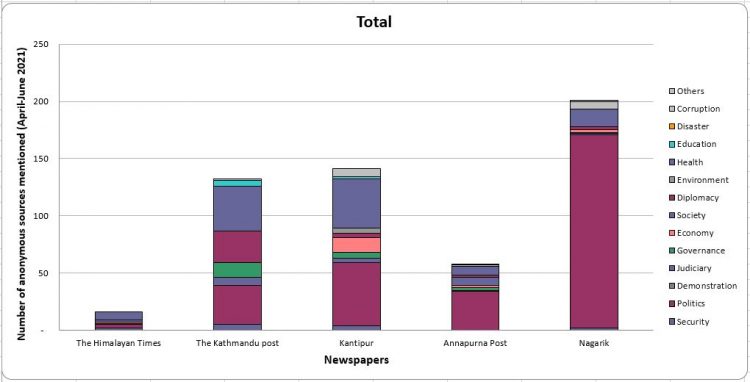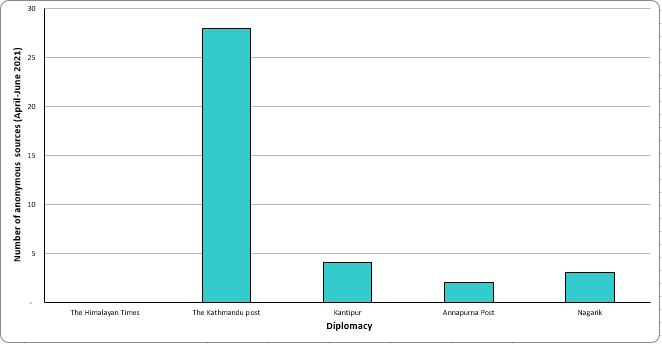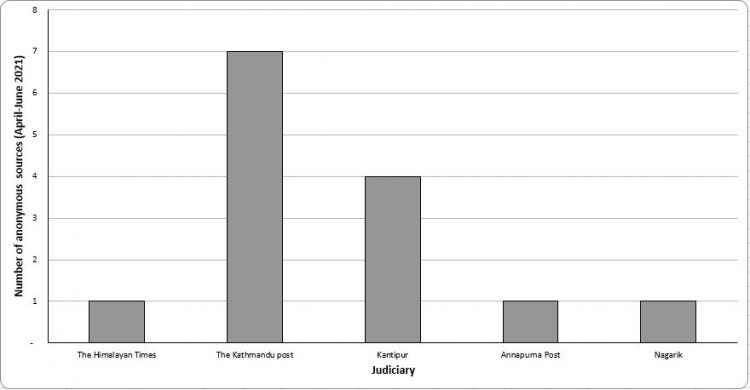Quarterly report (April-June, 2021) on anonymous sources in newspapers
South Asia Check / July 2, 2021

During the past three months – between April 1 and June 30, 2021 – among the five major national dailies that we monitored, Nagarik used the most number of anonymous sources in its front page reports. It used a total of 201 anonymous sources in the front page reports during the period.
South Asia Check has, for the past several years, been tracking the use of anonymous sources in the news reports published on the front pages of six leading national dailies of Nepal – Kantipur, Nagarik, Annapurna Post, The Kathmandu Post, Republica and The Himalayan Times. While the first three are Nepali language newspapers, the last three are English dailies. But Republica remains out of print since mid-April last year, so this report is based on the five newspapers.
After Nagarik, the dailies using the most number of anonymous sources were Kantipur, The Kathmandu Post, Annapurna Post and The Himalayan Times respectively. The Himalayan Times used the least number of anonymous sources, 16 in total, this quarter.
The front page reports of the five dailies used altogether 548 anonymous sources this quarter.
Most of the news reports on the front pages of the newspapers were about politics. Anonymous sources were mostly used in politics-related news reports (in 295 instances). Nagarik and Kantipur were the first and second national dailies respectively using the highest numbers of anonymous sources in their political reports; Nagarik used anonymous sources in 169 instances and Kantipur in 55 instances in such reports.












Health is the second topic in the Nepali newspapers where anonymous sources were used in highest numbers. During this period, anonymous sources were used in 112 instances in health-related news reports in the five newspapers.
Quoting anonymous sources in news reports is not an abnormal practice. Regarding the use of anonymous sources in news reports, Clause 4.8(1) of the ‘Journalist’s Code of Conduct, 2016 (first amendment 2019)’ issued by the Nepal Press Council states the following:
“Source should be quoted for the reliability of the news. However, while quoting the source, the name and identity of such source should be kept confidential so as to avoid any serious damage to the source.”
The identity of news source should be protected only if revealing the source’s identity can cause serious harm to him/her.
But some news reports published during this period have quoted anonymous sources even when there is no apparent need to do so.
For example, a report headlined ‘Let’s not be careless just because markets have reopened’ published in a Nepali-language daily stated, A senior health ministry official said, “If there are more street protests it will be tantamount to inviting a third wave of infection.”
Another report titled ‘Highly contagious triple mutants in 97%’ in a Nepali-language daily states: “According to a health ministry source, samples from Covid-dead and Covid-recovered people were collected from all the seven provinces for sequencing.”
The aforementioned use of anonymous sources are unjustified because disclosing the sources’ identities wouldn’t cause serious harm to the sources.
Haphazard use of the anonymous sources diminishes the credibility of news reports and the newspapers publishing such reports. Click here to download the spreadsheet of anonymous sources statistics prepared by South Asia Check.
This material is copyrighted but may be used for any purpose by giving due credit to southasiacheck.org.
Comments
Latest Stories
- In Public Interest Covid-19 cases are low, but that’s not an excuse to avoid vaccination
- In Public Interest What is BF.7, the sub-variant that has the world by its grip?
- In Public Interest Threat of a new Covid-19 wave looms large amid vaccine shortage in Nepal
- In Public Interest As cases decline, Covid-19 test centres in Kathmandu are desolate lot
- In Public Interest Dengue test fee disparity has patients wondering if they’re being cheated
- In Public Interest As dengue rages on, confusion galore about what it is and what its symptoms are. Here’s what you need to know
In Public Interest
 Covid-19 cases are low, but that’s not an excuse to avoid vaccination
The Pfizer-BioNTech bivalent vaccines authorised by the Nepal Government provide better protection a...
Read More
Covid-19 cases are low, but that’s not an excuse to avoid vaccination
The Pfizer-BioNTech bivalent vaccines authorised by the Nepal Government provide better protection a...
Read More
- What is BF.7, the sub-variant that has the world by its grip?
- Threat of a new Covid-19 wave looms large amid vaccine shortage in Nepal
- As cases decline, Covid-19 test centres in Kathmandu are desolate lot
- Dengue test fee disparity has patients wondering if they’re being cheated
- As dengue rages on, confusion galore about what it is and what its symptoms are. Here’s what you need to know